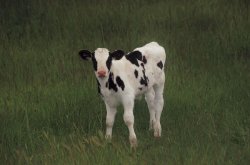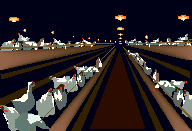

To send a message to an author, click on the author's name at the end of the article.
This Month in Ag Connection | Ag Connection - Other Issues Online
This article will discuss two strategies for achieving maximum farm machinery life. These strategies are: machinery maintenance and engine tune-ups.
Machinery Maintenance
A Midwest study showed that many farmers could reduce machinery repair costs 25 percent by improving routine maintenance procedures. With a yard full of machinery, that savings can be significant. As an example, an $80,000 tractor will typically require about $24,000 in repair costs during 5,000 hours of operation when receiving average maintenance. This cost can be decreased to approximately $18,000 by increasing the level of service management. Some ideas for improving maintenance procedures are as follows.

Timely preventative maintenance and inspection will not only help reduce major problems and downtime, it will also help identify problems when they can be corrected with relatively minor repairs.
Equipment repaired during the winter can save money on service at mechanics' shops. An effective machinery service program requires good record keeping. It should not be based on the operator's feelings or memory as to when a machine needs attention.
The maintenance program must be based on fact as determined by an accurate service record for each piece of equipment as recommended by the operator's manual and adjusted to individual conditions.
To aid record keeping, mount a service record chart for each vehicle and implement in a prominent area of the farm shop or in a service "record book." Identify hour maintenance intervals such as 10, 50, 100, 250 and 500 so it is convenient to identify, perform and record the services needed. Be sure to follow the "Preventative Maintenance Guide" in the operator's manual for each particular piece of equipment. Carry a small notepad in each cab to record problems and observations as they arise.
Engine Tune-Ups
Diesel and gas engines require periodic tune-ups. As engines operate, they lose power and fuel efficiency. To obtain the optimum performance from an engine, the power produced and the fuel consumed should be checked and compared to the University of Nebraska Tractor Test data. Test reports can be obtained from the Nebraska Tractor Testing Laboratory, Biological Systems Engineering Department, 35th & East Campus Loop, P.O. 830832, University of Nebraska, Lincoln, NE, 68583-0832 (http://tractortestlab.unl.edu/).
Test results include several ratings for each tractor. For comparative purposes, look at the figures that indicate tractor PTO horsepower and specific fuel consumption at maximum PTO horsepower. The next step is to test the tractor. The tractor should be tested on a certified PTO dynamometer found at most equipment dealers. Attach the tractor's power take-off to a dynamometer, warm the engine up and check to see if it produces rated PTO horsepower. If tractor power is down by more than 5 percent, adjustments or a tune-up is needed. A tune-up may include changing air and fuel filters, cleaning and adjusting injector nozzles, and adjusting engine timing.
Another important part of tractor operation is checking fuel efficiency. This can be done at the time the tractor is operating on the PTO dynamometer. After the tractor is warmed to operating temperatures, stop the tractor and fill the fuel tank completely full. Operate the tractor at rated speed and load for 30 minutes (longer for more accurate results), then stop the tractor and refill the tank to the previous level, keeping track of the gallons needed. Fuel efficiency will give an idea of the engine's condition.

Specific fuel consumption or fuel economy is measured in horsepower-hours per gallon (hp-hr/gal), much as automobile fuel efficiency is measured in miles per gallon. To calculate the efficiency of the tractor, first determine the gallons of fuel used in one hour. For example, a diesel tractor producing 155 hp and using 5.5 gallons in 30 minutes would use 11 gallons in an hour. Divide the 155 horsepower by 11 gal/hr, which gives a fuel efficiency of 14 hp-hr/gal.
Compare this figure to University of Nebraska Tractor Test data during the PTO tests at rated horsepower. If the current efficiency is 5 to 10 percent less than original, there may be a problem that needs correction. If an engine is showing a 5 percent reduction in fuel efficiency, it is wasting about 5 percent of the fuel. In a 155 horsepower tractor burning 11 gal/hr, this adds up to 0.55 gallons of fuel wasted every hour or 275 gallons wasted every 500 hours of use.
Summary
No single item will have a large effect, but a combination of practices can have a large impact on costs, improve machine reliability for many years to come, and improve profit margins.
The information for this article was obtained from a guide sheet available from Virginia Tech entitled Five Strategies for Extending Machinery Life, http://www.ext.vt.edu/pubs/bse/442-451/442-451.html
Source: Kent Shannon, MU Extension Natural Resource Engineering Specialist
This Month in Ag Connection | Ag Connection - Other Issues Online
The calving process in beef cows can be challenging, especially when things don't go normally. Dr. Bob Larson, former MU Extension Veterinarian, offered advice on calving issues, and I've listed a few of his comments below.

The calving process can be described in three stages. Stage one is dilation of the cervix. This process can take from 4 to 6 hours in heifers and 2 to 4 hours in cows. Stage two is delivery of the calf. This can take from 3 to 6 hours in heifers and 2 to 4 hours in cows. The final stage is delivery of the placenta and can last from 2 to 8 hours. These times are averages and of course individual animals can vary quite a bit from these estimates.
It is important for producers to be able to recognize abnormal deliveries. Dr. Larson recommended a couple of targets to watch for during Stage two of delivery. He suggested there may be a potential problem when the time from when feet are visible to birth is longer than two hours or if no progress is made in a 30 minute period. If one of these two things happen, examination is warranted.
When examining an animal, it is very important to have the proper equipment available. All equipment should be clean and have plenty of water available. Use proper restraint on the animal. Clean the animal and use plenty of lubricant before and during the examination.
Upon examination, you should be able to determine one of the following:
If any of these three things happens, stop and get help.
If you are providing assistance in delivery, do not use excessive force (no tractors allowed) when extracting the calf. While occasional calving difficulties are a normal part of beef cattle production, excessive calving problems can be indicative of more serious management issues that need to be addressed. These could range from nutrition to bull selection.
Please contact your local University of Missouri Extension Livestock Specialist:
Wendy Flatt - Howard County
Gene Schmitz - Benton County
Mark Stewart or Dee Cooper - Callaway County
Source: Gene Schmitz, MU Extension Livestock Specialist
This Month in Ag Connection | Ag Connection - Other Issues Online
2009 will be a year in which producers will be challenged to manage inputs and reduce risks. Researchers have developed a list of 24 ways in which to help jump-start corn yield.

Source: Wayne Crook, MU Extension Agronomy Specialist
This Month in Ag Connection | Ag Connection - Other Issues Online

Poultry litter has long been used as a source of nitrogen, phosphorus, and potassium on crop, pasture, and hay ground and for good reason. The nutrient content of poultry litter can vary significantly depending on source but, in general, a ton of poultry litter contains approximately 55 pounds of nitrogen, 55 pounds of phosphate, and 45 pounds of potash. To purchase these nutrients in commercial form, it would cost approximately 75 dollars at today's prices. Considering a ton of poultry litter costs 45 dollars delivered and spread, utilizing this alternative fertilizer source can result in significant savings. There are a few other things to consider, however, before deciding to use poultry litter on tall fescue meant for seed production.
As mentioned above, the nutrient content of poultry litter can vary significantly depending on the source of the litter. If poultry litter is to be used, it is important to find out exactly how much of each nutrient is present in the litter. Applying poultry litter with a nutrient content less than what is expected may result in the needs of the crop not being met. Using poultry litter with a nutrient content higher than expected may result in extra amounts of one or more nutrient being applied in the soil. Over a period of time, this extra application of a nutrient can result in excessive soil test levels, leading to diminished nutrient availability or even water quality issues. The nutrient content of poultry litter should always be analyzed prior to field application.
Nitrogen in poultry litter exists in two forms, organic and inorganic. At the time of application only about 10 percent of poultry litter is inorganic, or immediately available to the plant. The rest of the nitrogen, or the organic portion, becomes available over a period of about 6 months. As a result, poultry litter can be classified as a slow-release fertilizer, and therefore works better in situations where small amounts of nitrogen are needed over time, such as in a pasture system, as opposed to a cropping or hay system where a large amount of nitrogen is needed in a short period of time.

In addition, only about half of the nitrogen in poultry litter ever becomes available to the plant meaning that, in a ton of litter, phosphorus and potassium are applied at rate nearly double that of nitrogen. Because of this, litter should be considered primarily a phosphate and potash fertilizer, as opposed to a nitrogen fertilizer.
If poultry litter is used, it should be applied based on the phosphorus and potassium needs of the plant and commercial fertilizers should be added to meet the remaining nitrogen requirements of the plant. If poultry litter is applied to meet the nitrogen requirements of the plant, it will result in excessive soil test levels of phosphorus and potassium.
Whether poultry litter is suitable for tall fescue seed production depends entirely on whether the soil needs phosphorus and potassium and when the litter is applied. If phosphorus and potassium are not needed, poultry litter should not be used. If phosphorus and potassium are needed, poultry litter can be used on seed fields, provided it is applied at the right time. High seed yields depend on two factors: tiller development and application of nitrogen in early winter. Poultry litter applied in the late summer or early fall may limit light penetration needed for the tillers to develop. An alternative would be to apply the litter in winter, after the tillers have developed. While this is certainly feasible, it may not be practical because a commercial source of nitrogen would also likely be needed.
There are two times when application of poultry litter on tall fescue seed fields is ideal. The first is before fescue is ever planted. If a field is going to be planted in tall fescue, and phosphorus and potassium are needed, poultry litter is an ideal choice. The nitrogen in the litter will also be beneficial to the early growth and development of the fescue. The other ideal time to apply poultry litter is right after seed is harvested in the summer. Many tall fescue seed producers graze their fields in the late summer and fall. Application of poultry litter right after seed harvest will encourage regrowth for grazing. The nitrogen in the poultry litter will also help with tiller development in late fall. Once again, this should be done only if phosphorus and potassium are also needed.
Source: Travis Harper, MU Extension Agronomy Specialist
This Month in Ag Connection | Ag Connection - Other Issues Online
Publishing Information
Ag Connection is published monthly for Northeast and Central areas of Missouri producers and is supported by the University of Missouri Extension, the Missouri Agricultural Experiment Station, and the MU College of Agriculture, Food and Natural Resources. Managing Editor: Mary Sobba.